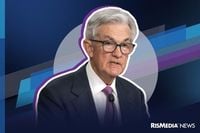On June 2, 2025, Federal Reserve Chair Jerome Powell delivered a pivotal speech at the Federal Reserve’s 75th anniversary of its International Finance Division in Washington, D.C., marking a moment of reflection on decades of monetary policy and signaling subtle shifts in the economic landscape. While Powell refrained from announcing any immediate changes to interest rates, his remarks touched on the complex evolution of the global financial system, the challenges facing the U.S. economy, and the increasingly significant role of digital assets such as Bitcoin.
Powell began by highlighting the historical context of the Federal Reserve’s role since World War II, noting that the United States emerged as a global economic superpower with the Bretton Woods Agreement positioning the U.S. dollar and the Fed at the heart of the international financial system. “International economics and finance have become increasingly large, complex and significant in recent years,” Powell said, emphasizing that foreign economic relations continue to present issues “of the first magnitude.”
However, Powell also acknowledged a fundamental shift in monetary policy that began in the 1970s, marking the end of the Bretton Woods era and the decoupling of the dollar from the gold standard. This break, he explained, required policymakers to navigate more volatile movements of the U.S. dollar and adapt their approach accordingly. “The end of the Bretton Woods era fundamentally changed the conduct of monetary policy,” Powell stated, adding that the Fed’s job had become more complicated in managing these new dynamics.
Despite the historic overview, Powell was cautious about providing any concrete signals regarding future interest rate decisions. His message was clear: the Fed remains data-dependent and will hold rates steady until sustained progress is made on inflation. This stance dashed hopes for imminent rate cuts, a point underscored by the Organization for Economic Cooperation and Development’s (OECD) recent economic outlook, which projects U.S. GDP growth to slow from 2.8% in 2024 to 1.6% in 2025 and 1.5% in 2026. The OECD also flagged potential risks from proposed tariffs by former President Trump, warning these could further cloud economic visibility and growth prospects.
Powell’s speech also addressed the growing prominence of the cryptocurrency sector, an area the Fed has been increasingly scrutinizing. He acknowledged the “turmoil” that has plagued digital asset markets, from fraud to instability, and stressed the need for comprehensive and consistent regulation. “The U.S. needs comprehensive and consistent regulation that encourages innovation without compromising financial stability,” Powell said. He argued that clear guidelines would help legitimize the space, weed out bad actors, and boost confidence among both institutional and retail participants engaging with blockchain-based assets.
These remarks arrived amid ongoing debates among federal agencies, including the Securities and Exchange Commission (SEC) and Commodity Futures Trading Commission (CFTC), over how to define and regulate various facets of the crypto economy—from stablecoins to decentralized finance platforms. Powell’s balanced tone provided a measure of optimism to an industry often overshadowed by enforcement actions and legal uncertainties.
Just hours after Powell’s speech, Strike CEO Jack Mallers released a fiery video interpreting the Fed Chair’s comments as an admission of systemic failure in the current monetary system. Mallers declared that Powell had “finally said the quiet part out loud,” acknowledging that the post-World War II monetary system is collapsing and that Bitcoin represents the only rational response.
“The Bretton Woods era is over. And they’re telling you,” Mallers said, eyes locked on the camera. “They’re invalidating us Bitcoiners—by validating everything we’ve been saying for years.” He explained that before the gold standard was abandoned, the Fed’s job was to defend the dollar peg, but divorcing from gold also meant divorcing from the physical constraints of nature. “And the world’s been a mess ever since,” he added.
Mallers rooted his critique in physics, emphasizing that assets like gold and Bitcoin are governed by immutable physical laws, unlike fiat currency which can be printed without limit. “Proof-of-work ties us to reality. That’s what makes Bitcoin the hardest asset humans have ever known,” he said.
He interpreted Powell’s acknowledgment of the Fed’s increasingly complicated role as an admission that the central bank has become a “machine for volatility suppression,” managing politics, leverage, and market chaos rather than true price stability. Mallers warned that the Fed is laying the groundwork for a regime shift, possibly adjusting the inflation target from 2% to 4% or adopting yield curve control to help fund the U.S. government. “If Powell comes out and says the inflation target is 4%, not 2%—boom,” Mallers said. “If he says the Fed will help fund the US government through some form of yield curve control—boom. This was the first breadcrumb. There are more coming.”
He also cited a recent Reuters article titled “Historic Dollar Fall Needed to Eliminate US Trade Deficit” to highlight the severity of the situation, concluding, “This is a monetary regime change. You don’t get many in a lifetime. And Bitcoin is going to play a massive role in what comes next.”
Meanwhile, markets responded with a mix of caution and resilience. Bitcoin briefly dipped below $103,000 over the weekend preceding Powell’s speech but bounced back to trade above $105,000 following his remarks. As of June 3, 2025, BTC was trading at approximately $105,319, reflecting a slight uptick amid ongoing macroeconomic uncertainties.
Powell’s recent meeting with President Trump, held just days before the speech, underscored the tension between monetary policy and political pressures. While Powell emphasized that policy decisions would be data-driven, the White House press secretary noted that Trump believed the Fed chair was making a mistake by not lowering interest rates, suggesting that this stance placed the U.S. at an economic disadvantage compared to countries like China.
Despite these challenges, consumer spending in the U.S. remains robust, and inflation metrics such as the Personal Consumption Expenditures (PCE) index for April 2025 aligned with forecasts. Treasury yields showed mixed signals, with the 10-year yield dropping below 4.5% while the 30-year yield hovered near 5%, reflecting a cautious but steady market environment ahead of the Federal Open Market Committee’s next meeting scheduled for June 17-18, where rates are expected to remain unchanged.
Jerome Powell’s speech, therefore, encapsulated a delicate balancing act: honoring the Federal Reserve’s historical legacy while navigating an era defined by economic uncertainty, geopolitical tensions, and the digital transformation of finance. Meanwhile, voices like Jack Mallers’ highlight the growing debate over the future of money itself, suggesting that Bitcoin could emerge as a cornerstone in the next chapter of global monetary policy.




